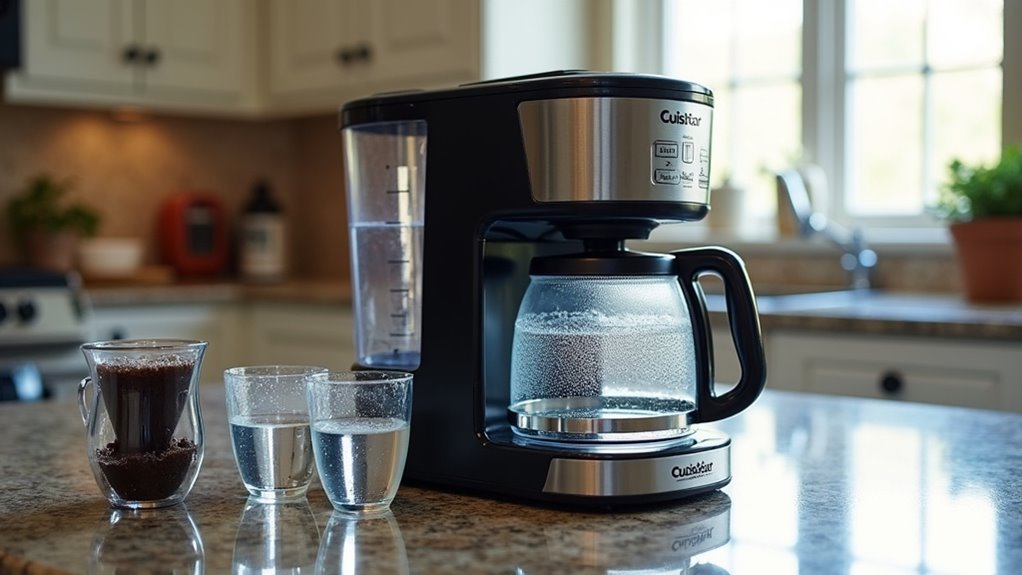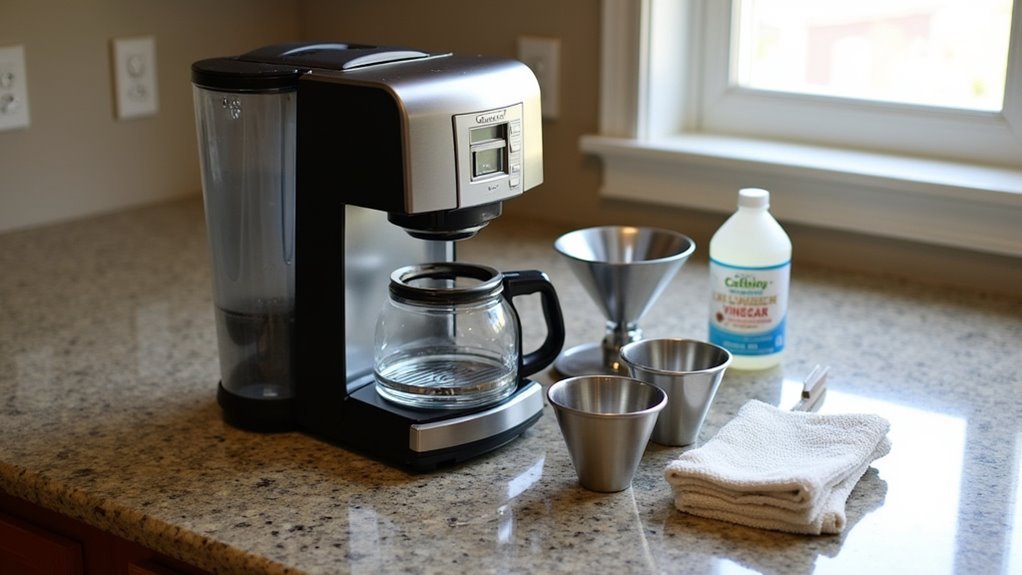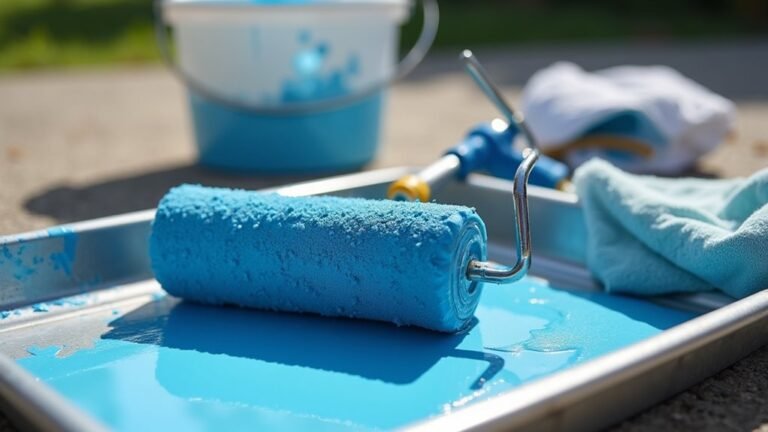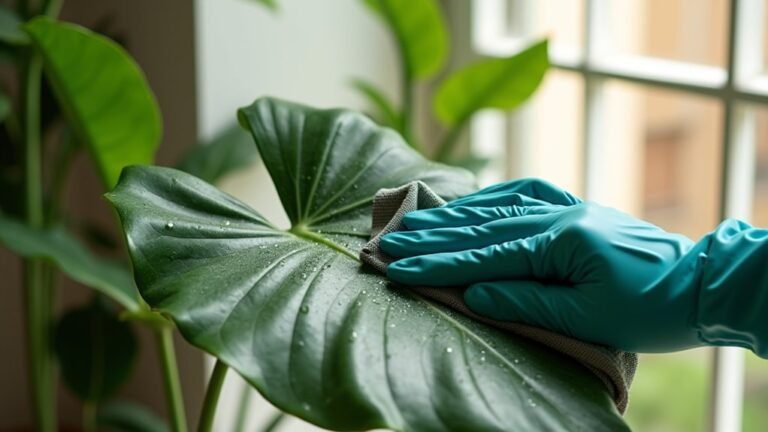Staring at a dirty coffee maker is something we’ve all experienced. If you own a Cuisinart Dual Coffee Maker, cleaning it might seem like a big task, but it’s actually pretty simple. Regular cleaning keeps your coffee tasting fresh instead of bitter and stale.
According to Sarah Stemen, Product Education Manager at Cuisinart, “The number one reason for coffee maker problems is lack of regular cleaning, which can affect both the taste of your coffee and the life of your machine.”
Just like you wouldn’t use the same dirty plate day after day, your coffee maker needs regular washing too. Think of it like brushing your teeth – it’s a basic habit that makes a big difference. When you skip cleaning, old coffee oils and mineral buildup can make your morning cup taste bad and even stop your machine from working right.
Regular cleaning also helps your coffee maker last longer, saving you money in the long run. Plus, you’ll get better-tasting coffee every morning, which is what we all want from our machines.
Remember, taking care of your coffee maker isn’t just about keeping it clean – it’s about making sure every cup of coffee you brew tastes as good as possible.
Dual Brewing Convenience Explained

The Cuisinart Dual Coffee Maker is, I think, one of those brilliant innovations that makes you wonder how we managed before.
We love how it lets us brew both a single K-Cup and a full carafe simultaneously—perfect for those mornings when I need my coffee immediately while my partner prefers a different roast.
With simple controls and a compact footprint, it’s basically two machines in one. Regular maintenance, such as monthly descaling, is essential to ensure optimal performance and longevity of the machine.
##
Let’s talk about keeping your Cuisinart Dual Coffee Maker in tip-top shape with some essential cleaning tips and practices to avoid.
I think proper maintenance not only extends the life of your machine but also guarantees your morning brew tastes fantastic every time. Regular maintenance keeps appliances running efficiently and can save you money in the long run.
We’ll walk through the cleaning steps, share some common mistakes to avoid, and finish with some final thoughts on maintaining your dual brewer for years to come.
Things to Do When Cleaning A Cuisinart Dual coffee maker
Maintaining your Cuisinart Dual Coffee Maker requires regular cleaning to achieve peak performance and delicious coffee.
The cleaning process involves several key steps that target different components of the machine to remove coffee residues, mineral buildup, and other contaminants that can affect the taste of your brew and the longevity of your appliance.
- Descale regularly using a 3:1 water-to-vinegar solution, either by activating the Clean button or manually running a brew cycle with this mixture.
- Follow descaling with a fresh water rinse cycle to remove any lingering vinegar taste or smell.
- Hand wash the carafe and filter basket with warm soapy water after each use to prevent oil buildup and staining.
- Replace or rinse the charcoal water filter every 60 days or 60 uses to maintain water quality.
- Wipe down the exterior of the machine with a damp cloth to remove dust and coffee splatter.
- Clean the brew basket and spray head to achieve even water distribution during brewing.
- Empty and clean the drip tray to prevent mold and bacterial growth.
Things to Avoid When Cleaning A Cuisinart Dual coffee maker
Properly maintaining your Cuisinart Dual Coffee Maker guarantees both best performance and the best-tasting coffee.
While regular cleaning is essential, there are certain practices that can damage your machine or compromise your brewing results if not avoided.
Understanding these cleaning don’ts will help extend the life of your coffee maker and guarantee your morning brew remains delicious.
- Cleaning while plugged in: Always unplug your coffee maker before performing any thorough cleaning to prevent electrical hazards and potential shock.
- Using undiluted vinegar: Never use straight vinegar for descaling; always dilute with water in a 1:3 ratio to prevent damage to internal components and seals.
- Skipping the rinse cycle: Failing to run 2-3 fresh water cycles after descaling leaves vinegar residue that will affect coffee taste and potentially damage components.
- Using abrasive cleaners: Harsh cleaners or scouring pads can scratch the machine’s exterior and remove protective finishes; stick to soft cloths and mild cleaners.
- Cleaning without emptying first: Always remove used grounds and rinse the carafe and filter basket before deeper cleaning to prevent spreading coffee residue throughout the machine.
- Submerging the base: Never immerse the main unit in water, as this will damage electrical components; only detachable parts should be fully submerged.
- Using dishwasher for all parts: While some components may be dishwasher-safe, always check the manual as certain parts can warp or degrade in high heat.
Steps
Keeping your Cuisinart Dual Coffee Maker clean is essential for maintaining ideal performance and ensuring your coffee tastes its best.
Regular cleaning prevents mineral buildup, removes coffee oils that can turn rancid, and extends the life of your machine.
The cleaning process is straightforward and should be performed every 1-3 months, depending on your water hardness and frequency of use.
Step 1: Prepare the cleaning solution by mixing three parts water with one part white vinegar.
Step 2: Fill the water reservoir with this solution.
Step 3: If your model has a Clean button, press it and follow the machine’s prompts to complete the cleaning cycle.
Step 4: For models without a Clean button, run a full brew cycle with the vinegar solution.
Step 5: After the cleaning cycle completes, run 1-2 additional cycles with fresh water to remove any vinegar residue.
Step 6: Remove and hand wash the carafe and filter basket with warm, soapy water.
Step 7: Check the charcoal water filter and replace it if you’ve used it for more than 60 days or 60 brew cycles.
Step 8: Wipe down the exterior of the machine with a damp cloth to remove any coffee stains or fingerprints.
Final Thoughts
Taking care of your Cuisinart Dual Coffee Maker doesn’t have to be complicated.
Regular descaling every 1-3 months and replacing filters every 60 days really does make a difference in both taste and machine longevity.
We’ve found that unplugging before deep cleaning and running a water cycle afterward prevents any cleaning residue from affecting your next brew.
Perhaps most importantly, these simple habits will keep your coffee tasting great for years to come.
##

Regular cleaning of your Cuisinart dual coffee maker isn’t just about maintaining appearances—it’s essential for guaranteeing delicious coffee and extending your machine’s lifespan.
Neglect your coffee maker and you’ll taste the consequences in every cup—proper maintenance is non-negotiable for quality brewing.
By following the simple cleaning routine outlined in this article—descaling with vinegar solution every 1-3 months, replacing the charcoal filter regularly, and washing removable parts after each use—you’ll prevent mineral buildup and eliminate residues that can affect coffee flavor. Regular care is essential for efficient operation of your coffee maker, much like it is for a tankless water heater.
Remember that a few minutes of maintenance today saves you from poor-tasting coffee tomorrow and potentially costly repairs down the road.
Your Cuisinart coffee maker is an investment in your daily coffee ritual, and proper care guarantees it will continue delivering that perfect cup for years to come.
Set a regular cleaning schedule that works for your household’s coffee consumption patterns, and you’ll enjoy consistently great coffee with minimal effort.
Your taste buds (and future self) will thank you for taking these simple steps to care for your coffee maker!






